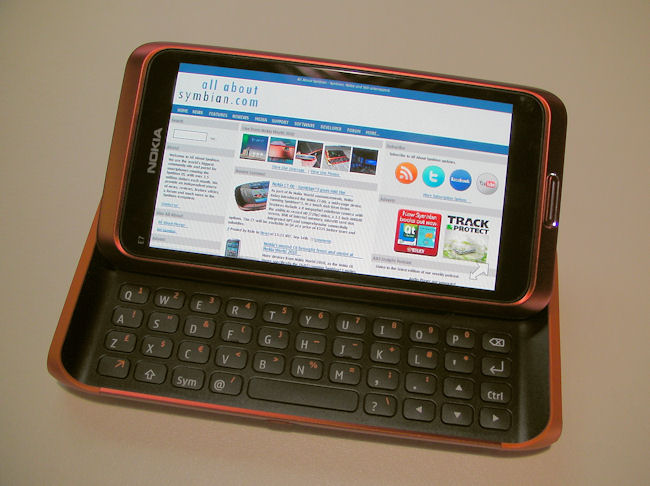| Nokia E90 | Nokia E7 | |
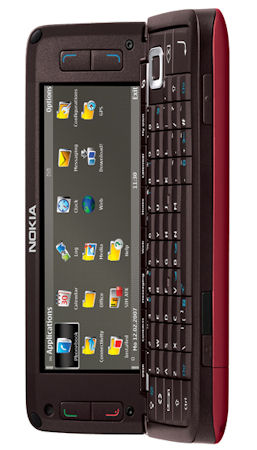 |
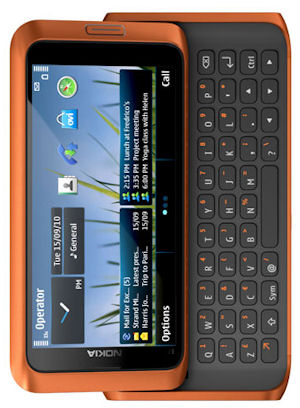 |
|
| Form factor, size, weight | Steel clamshell design, with inner and outer screens, both T9 and qwerty keypads, occasionally useful as a blunt instrument to ward off attackers(!), 132 x 57 x 20 mm, 210g | Aluminium shell with hinged screen that slides up and tilts, to reveal a qwerty keypad, 123.7 x 62.4 x 13.6 mm, significantly lighter and smaller, at 176g |
| Display | External 2" QVGA transflective (so great in sun), internal 4", 800 by 352 transflective (ditto re: sun) | 4" 640 by 360 ClearBlack Display OLED capacitive touchscreen (expected usable, though not brilliant, in sunlight) |
| Interface, text entry | D-pad and 5-row keyboard-based, with additional one-touch application shortcut keys | Touch and 4-row keyboard, not as much travel as on the E90's, but reported still very usable |
| Speed, RAM, performance | 90MB free after booting, OS and multitasking fast but some apps are sluggish due to non-optimised code for the wide-screen interface | 100MB+ free (expected) after booting, OS and apps run quickly thanks to faster processor, slicker OS and extra graphics chips |
| Capacity | 120MB internal (C) disk, plus 16GB on microSD | 350MB internal (C) disk, plus 16GB mass memory, no card expansion |
| Connectivity | Wi-Fi, Bluetooth 2, GPS, quad band GSM, single band 3G | Wi-Fi, Bluetooth 3, GPS, quad band GSM, pentaband (850 / 900 / 1700 / 2100 /1900) 3G |
| Messaging and email | S60 Messaging, Nokia Messaging can be retrofitted | Email (evolution of Nokia Messaging?), plus Mail for Exchange, Microsoft Communicator Mobile |
| Web browsing | S60 Web, with Flash Lite 3 | Symbian Web with Flash Lite 4 and Flash 10 compatibility for media |
| Visual media | Realplayer, MP4 playback acceptable but usually requires some optimisation and preparation. YouTube client a free download but doesn't run smoothly full-screen. Image display slow and clunky. | Realplayer and core OS media playback very good, with MP4/H.264/H.263/WMV compatibility both full-screen and with tolerance of high resolutions and bit rates, thanks to the extra graphics hardware taking on most of the work. Image browsing and display fast and fluid. HDMI output to a digital TV, with Dolby Surround Sound. |
| Photo/video | Good (for its day) 3 megapixel auto-focus camera, with LED flash and VGA/30fps video capture with preset focus | 8 megapixel EDoF camera (so good for casual snaps but can't handle traditional macro photography (e.g. 'scanning' documents or business cards), 720p video capture (though we don't know yet if this has initial or preset focus) with associated video editor |
| Audio | 2.5mm output (adapter needed for plugging in traditional headphones), plus loud stereo speakers | 3.5mm output, mono speaker (performance not yet known) |
| Battery life | 1500mAh BP-4L, typically two days per charge | 1200mAh BL-4D, typically one day per charge (given increased media and Internet use?) |
| Navigation, Social location | Nokia Maps, navigation is paid for service but very cheap (10 Euros a year) for each region | Latest Ovi Maps with free worldwide navigation and extra services, plus digital compass |
| Application highlights | Quickoffice editing, Podcasting. Further software via PC download. | Quickoffice editing, F-Secure anti-theft and numerous widgets and services, including Facebook and Twitter homescreen widgets. Further software easily available in Ovi Store. |
| Price | Around £130 selling price on eBay | Around £500 from Dec 2010 |
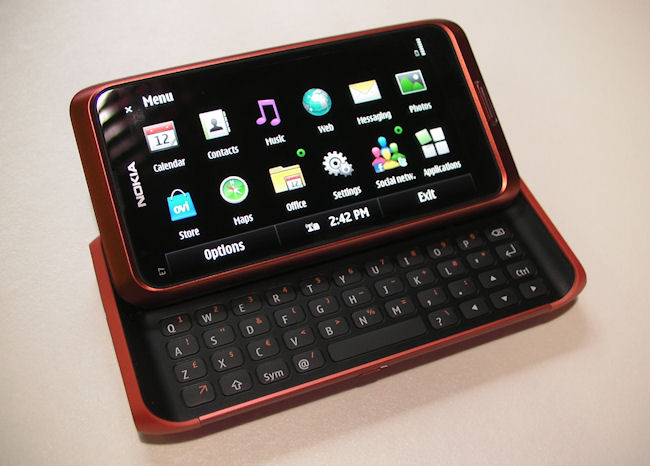
Expanding my comments in the original E7 launch story, I should note that I had a play with a pre-production E7 a while back and loved the overall form factor, with one caveat: the raised keyboard edges made thumb-typing on the edge keys a little awkward. In addition, the keys look to have less travel and overall feel than those on the E90 - though it's worth noting that later variants of the E90 had keys that were apparently a lot 'flatter' than those on my E90 (late) prototype.
The screen mechanism is almost a direct lift from the N97 - I haven't heard of a single N97 (or N97 mini) hinge breaking yet, so, despite the apparent fragility, I'd expect this to work very well. I also haven't heard of many E90s failing in terms of the hinge cable - reliability was always one of the watchwords of Nokia's Communicators and Eseries in general. Certainly having the display raised up at an angle fits in well with the 'desktop in your pocket' business focus and it'll make a good professional communications tool. There's only the one angle, of course, whereas on the E90 you could choose almost any angle you wanted.
The continued (from the N8, with which the E7 shares a lot of internal components) use of the BL-4D 1200mAh battery is a worry though. I know there are power efficiencies involved with the new chipsets and Symbian^3, but the Communicator range has always featured the biggest and best batteries that Nokia make, with careful use, some people have nurse-maided an E90 through a week on one charge while on trips away. In contrast, the E7 introduces use cases (as with many 2010 smartphones) - navigation, video playback, extended web browsing - which demand high battery drain - add these to the smaller battery and there's an obvious mismatch. For a consumer 'fun' smartphone, running out of juice at 4pm just means you won't be able to listen to music on the tube train home. For a serious business tool, running out of juice at 4pm means missing a deal or not being able to handle some critical emails. Not good.
Making this worse, the Communicator (like most pre-2010 phones) has always had a replaceable battery, giving the convenience of being able to swap batteries on the fly if needed (Rafe and I have been known to travel with several spare BP-4Ls in our pockets!) With its aluminium body, the E7 is like the N8 and has a non-user-replaceable battery - which in my view is a definite negative point. Sorry, Nokia - this is one Apple-esque trend that I really don't like and which will come back to bite E7 users in the years ahead - after a year of regular use, a 1200mAh battery will have fallen to about 1000mAh of usable capacity - which isn't a lot for a business-critical, 4"-screened Communicator.
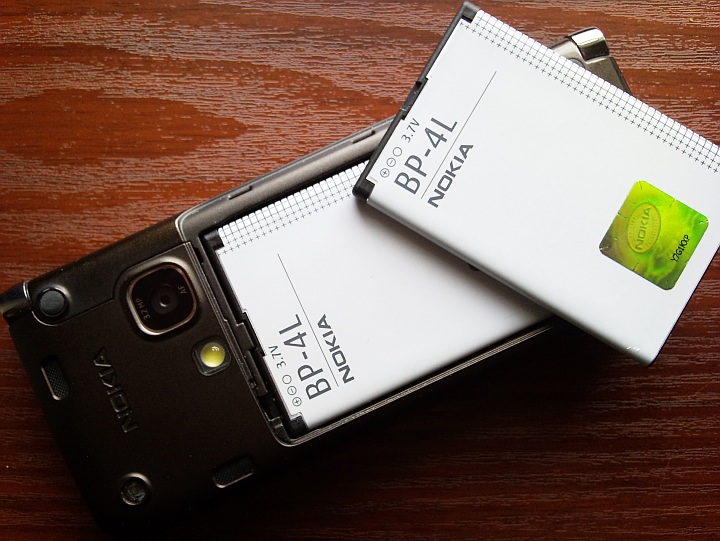
Along the same lines, not having a microSD slot is also annoying. Like many people, I'm used to carrying around a lot of media on a large microSD (16GB, in my case) and it's a real pain to come upon a device which doesn't accept cards. Yes, 16GB is a lot and most E7 owners won't fill it unless they opt to auto-fill from their music collections. But there'll be no taking captured 8mp photos or 720p videos and putting a card into a printer or other home media device, which is a shame. One saving grace is that USB on the go will at least let you copy files directly from the mass memory to a USB memory stick or microSD in a card adaptor - but it's all rather more fiddly than on the card-equipped E90.
Nokia's defense is that, with the unibody construction, there simply wasn't a way to include a microSD slot - and there's no battery cover, ergo you can't stick it under that either. Which is a trifle circular, since if they did have a removable battery.... see above!
Screen resolution has been widely commented on - looking at the raw numbers is a little disconcerting, with the four year old E90 having higher resolution, in terms of raw pixels, than the brand new E7. In practice, I don't believe that the 140 pixel difference in horizontal resolution will make much difference to most people. Yes, I'm sure my 11 year old with her eagle eyes could tell that the E90 showed sharper web renderings or more detailed photos. I know that my 48 year old eyes almost certainly can't. Given that the E7 is definitely aimed at more 'serious' buyers, who are more likely to have more years under their belts, I don't think screen resolution will be a serious issue once we get hold of the E7 and start using it for real.
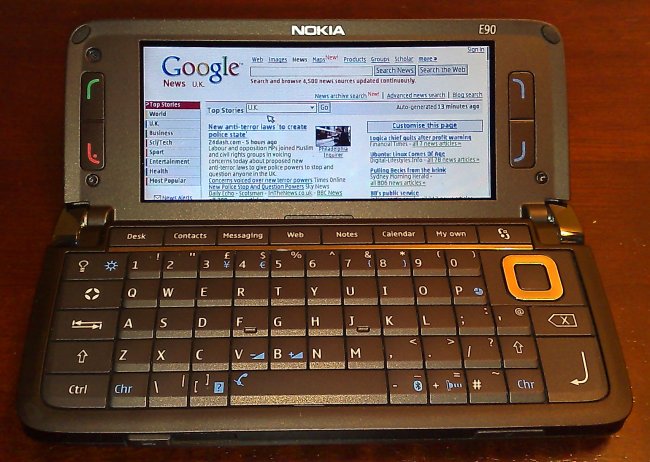
Finally, although taking photos and video isn't a front and centre use case for the E7, and despite my own assurances to people that EDoF cameras make great 'snap-takers', not being able to focus on an A4 document to 'capture' it and not being able to focus on a 3" business card (as you could do with the E90) is going to be a showstopper, those are core functions for some professionals.
Coming from the E90, there's a lot to like about the E7, of course, from the smaller, slimmer form factor and the extra brilliance of the screen to the far slicker handling of media (compared to the E90), plus modern tech like HDMI, a digital compass, pentaband 3G, Dolby Surround Sound and modern software extras like the built-in support for social widgets and clients, the Microsoft Exchange support out of the box, the possibility for great games. But I keep coming back to the 'x steps forward, y steps back' thought - yes, x may be greater than y, but shouldn't y be as close to zero as possible?
Steve Litchfield, AAS, 16 Sept 2010
